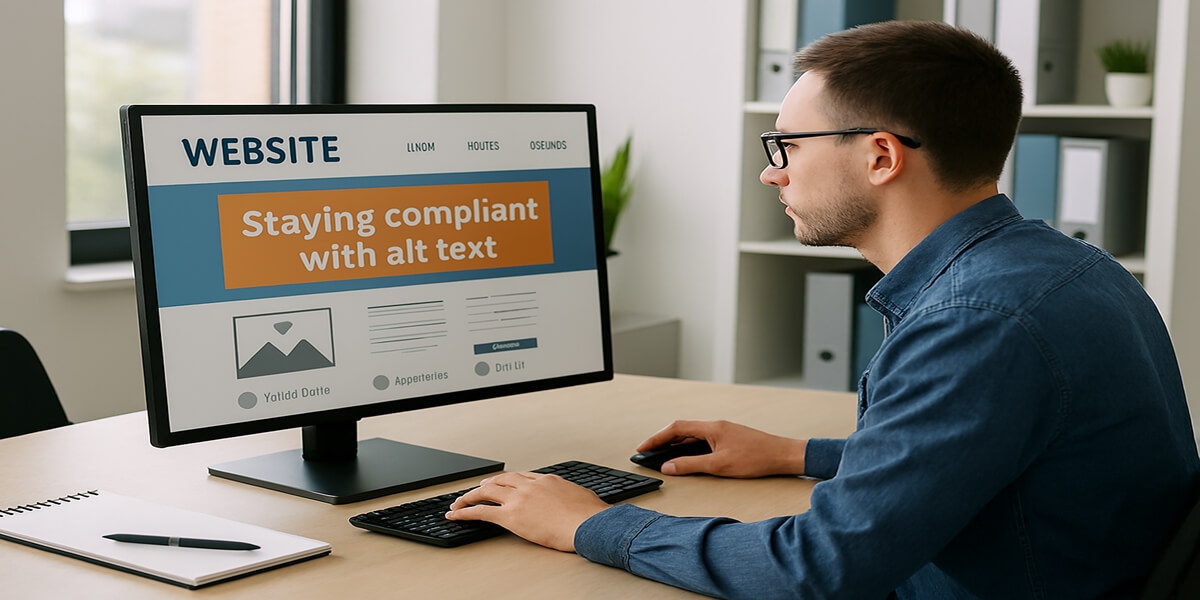Have you ever searched for something online, only to land on a website where the images didn’t load? What did you see? Chances are, you noticed a little text box in place of the image. That tiny snippet of text is called alt text — and it carries far more weight than most entrepreneurs realize.
If you are building or scaling your business, your website is one of your most powerful assets. It’s your digital storefront, your branding hub, and often the first impression you make on potential customers. And in that landscape, alt text is one of those details that can either elevate your brand visibility or leave opportunities on the table.
In this article, we’ll unpack what alt text is, why it matters, and how businesses can leverage it to maximize both accessibility and SEO. By the end, you’ll see how a few words of thoughtful description can help you win more traffic, trust, and conversions.
What Exactly Is Alt Text?
Alt text — short for alternative text — is the written description added to images on a webpage. Its primary purpose is to provide context when the image cannot be displayed or when a visitor is using a screen reader. But beyond accessibility, alt text plays a huge role in how search engines understand your content.
Here’s something that might blow your mind: Google’s sophisticated AI still can’t perfectly understand images without textual context. Search engines are also blind in a way without alt-text. While they can crawl and index your written words, they, however, can’t “see” your images. Without alt text, that valuable image content remains invisible to them. By adding descriptive alt text, you essentially translate your images into searchable language that boosts your overall SEO.
So while it may seem like a small technical detail, alt text is really a strategic tool.
Why Should I Care About Alt Text?
Here is why you should care :
1. Accessibility Builds Trust and Loyalty
Inclusivity is no longer optional. Many potential customers rely on screen readers due to visual impairments. If your website is missing alt text, you’re excluding a portion of your audience. By simply writing clear descriptions for your images, you show empathy and respect. And that builds loyalty.
2. Alt Text Fuels Your SEO
Search engines can’t interpret images the way humans can. By writing optimized alt text, you’re essentially whispering in Google’s ear: “Here’s what this picture is about.” This extra context can help your pages rank higher, especially when your alt text includes relevant keywords naturally.
For entrepreneurs, this is free organic traffic you can’t afford to miss. Every visitor who finds you through search is one step closer to becoming a customer.
3. Improves User Experience Beyond the Screen
Technical failures happen more than you think. Sometimes images don’t load. Maybe the user has a slow internet connection. Perhaps your image hosting service is experiencing technical difficulties. Sometimes corporate firewalls block certain image types or external resources. In mobile environments with limited data plans, users might disable image loading entirely to conserve bandwidth.
When that happens, alt text ensures users still understand the context. Instead of being confused by a blank square, they still get the full story.
In other words, alt text acts as your safety net. It guarantees your content communicates effectively even when technology fails.
4. Legal Compliance and Avoiding Risk
According to the World Health Organization, approximately 2.2 billion people worldwide have some form of vision impairment. That’s roughly one in four people on this planet.
In many regions, there are accessibility laws in place. These laws require websites to be usable by people with disabilities. Failing to be compliant can put a business at legal risk.
In 2023 alone, there were over 4,000 website accessibility lawsuits filed in the United States. That’s more than ten lawsuits every single day. Companies like Target, Netflix, and Domino‘s have faced high-profile lawsuits specifically related to website accessibility issues. Domino’s case went all the way to the Supreme Court.
These lawsuits are completely preventable. Simply adding alt text is one of the easiest ways to safeguard your business and stay compliant with regulations.
Most startups and small businesses with limited funds do not have the luxury of paying hefty settlements, so as site owners, it is best to get this remedy as soon as possible.
How to Write Effective Alt Text
Now that you know why it matters, let’s talk about how to write alt text that actually works.
1. Be Descriptive, Not Robotic
Instead of writing something vague like “image” or “photo,” describe what the picture shows. For example, instead of:
❌ “Dog”
✅ “Golden retriever puppy playing with a red ball in a park”
The second example not only paints a clearer picture for users but also gives search engines more context.
2. Keep It Concise
Alt text is not the place for lengthy sentences.
Aim for one short, clear description — usually under 125 characters. Screen readers cut off longer text, so brevity ensures clarity.
3. Use Keywords Naturally
If your target keyword fits naturally, use it. For example, if your keyword is “eco-friendly water bottle,” and your image shows that product, your alt text could read:
✅ “Eco-friendly stainless steel water bottle on a wooden desk”
Avoid keyword stuffing. Forcing phrases like “eco-friendly water bottle” into every image alt text looks spammy and hurts your SEO.
4. Skip Redundancy
You don’t need to write “image of” or “picture of” in your alt text.
Screen readers already announce that it’s an image. Jump straight into the description.
5. Prioritize Meaningful Images
Not every single image needs detailed alt text. Decorative elements (like background patterns or design flourishes) can have empty alt attributes (`alt=””`) so they don’t clutter the experience for screen readers. Focus your energy on product images, infographics, charts, and photos that add real value.
Use Cases for Alt Text
So, how do entrepreneurs apply this practically? Let’s look at a few scenarios.
E-commerce Businesses
If you sell products online, alt text is your silent salesperson. Well-written descriptions make your products discoverable in Google Images, which drives buying intent traffic straight to your store.
For example, instead of:
❌ “Shoes”
✅ “Women’s black leather ankle boots with side zipper”
That extra detail improves both search visibility and conversion. Despite its simplicity, alt text remains one of the most overlooked aspects of web development.
Content Creators and Coaches
If you publish blogs, webinars, or guides, alt text ensures your visuals (charts, screenshots, promotional graphics) contribute to SEO. It also makes your content more accessible to a broader audience, expanding your reach.
Startups and Small Businesses
When you’re building awareness on a budget, every ounce of organic visibility matters. Alt text is one of the cheapest SEO wins available. It helps your site compete with bigger players who may overlook this detail.
Personal Branding for Entrepreneurs
If you’re building a personal brand through photos, speaking events, or media features, alt text ensures your image-based content contributes to your discoverability. Imagine someone searching for “entrepreneur keynote speaker Singapore” — if your event photo has the right alt text, you could appear.
Common Mistakes Entrepreneurs Make with Alt Text
Despite its simplicity, many entrepreneurs miss the mark. Here are mistakes to avoid:
Keyword stuffing: Writing alt text like “alt text alt text entrepreneur SEO alt text” doesn’t fool Google.
Being too vague: “Business image” doesn’t add value.
Forgetting brand consistency: Use alt text to reinforce your brand voice subtly.
Ignoring charts and infographics: Data visuals need alt text too, or you lose SEO and accessibility benefits.
Final Thoughts: Don’t Overlook the Small Things
As entrepreneurs, it’s tempting to focus only on the big, flashy strategies — product launches, ad campaigns, scaling operations. But sometimes, it’s the quiet, overlooked details that make the difference between being found and being forgotten.
Alt text may look small on the surface, but its ripple effects touch accessibility, SEO, brand reputation, and even legal compliance. By investing just a few extra minutes to write thoughtful alt text, you’re investing in a better experience for your customers and a stronger foundation for your business.
Remember the 2.2 billion people with disabilities; though they may face visual challenges, they nonetheless represent real people with real purchasing power.
So next time you upload an image, don’t just leave that alt text box blank. Use it as a chance to improve your visibility and show your customers that you care.
It’s often the little things that make the biggest impact or sink a mighty ship. If you want professional help optimizing your digital presence, drop us a note as we specialize in strategies that ensure every detail of your online presence is working for you and not against you, including alt text.





